In today’s enlightened times, we embrace wildlife in all its forms. Animals and insects are crucial to our ecosystems and sustain our way of living as humans. At the same time, the last thing anybody wants is pests invading their living space, like when there’s a garden spider infestation in your house.
A garden spider or orb weaver spider in Washington State and Oregon has plenty of outdoor habitat options. They shouldn’t need to take up any of your living space. So it only makes sense for you to learn about these particular arthropods and how to protect your home from potential infestations including acquiring pest control services from professionals like Pest Pros when needed.
What is a Garden Spider?
The vast size of the black and yellow garden spider is rivaled by its massive, circular webs that the naked eye can’t miss. Despite their fearsome appearance suggesting they’re from a monster movie, having these particular arthropods in your garden is ideal due to their eating habits.
Here are some other black and yellow garden spider facts:
- The garden spider is also called the corn spider, writing spider, and banded garden spider. However, the technical name for this arthropod is the orb weaver spider.
- Females are easily identifiable through their yellow and black abdomens and the red or yellow markings on their eight black legs.
- When fully grown, the female black and yellow garden spider has a leg span that can reach three inches long from the back.
- Male garden spiders are smaller and less ornate in appearance, colored a drab brown and a quarter of a female’s size.
- A female’s massive, two-to-three-feet-wide web gets spun mid-summer when she’s seeking a mate and enough food for egg laying.
- Males build tinier webs within the female web. These webs are denser and less sophisticated. There can be several male webs within one female web.
Our team at Pest Pros has a vast knowledge about a variety of spiders including garden spiders which allows them to apply the most effective, customized pest control solution.
Garden Spider Vs. Orb Weaver Spider
The orb weaver spider and the garden spider are the same.
More specifically, the orb weaver spider family has a variety of spider body types and traits. Some of their bodies are black and yellow (like garden spiders), or they can be gray, orange, or brown.
Orb weaver spiders weave their prey-catching webs in bushes, gardens, and your home (which we’ll discuss later) and stay nearby to pounce on their future meal. They carry a mostly harmless venom in their bites that may cause red bumps to sprout on your skin. At worst, the resulting blemish will swell mildly and cause minor itching in most cases.
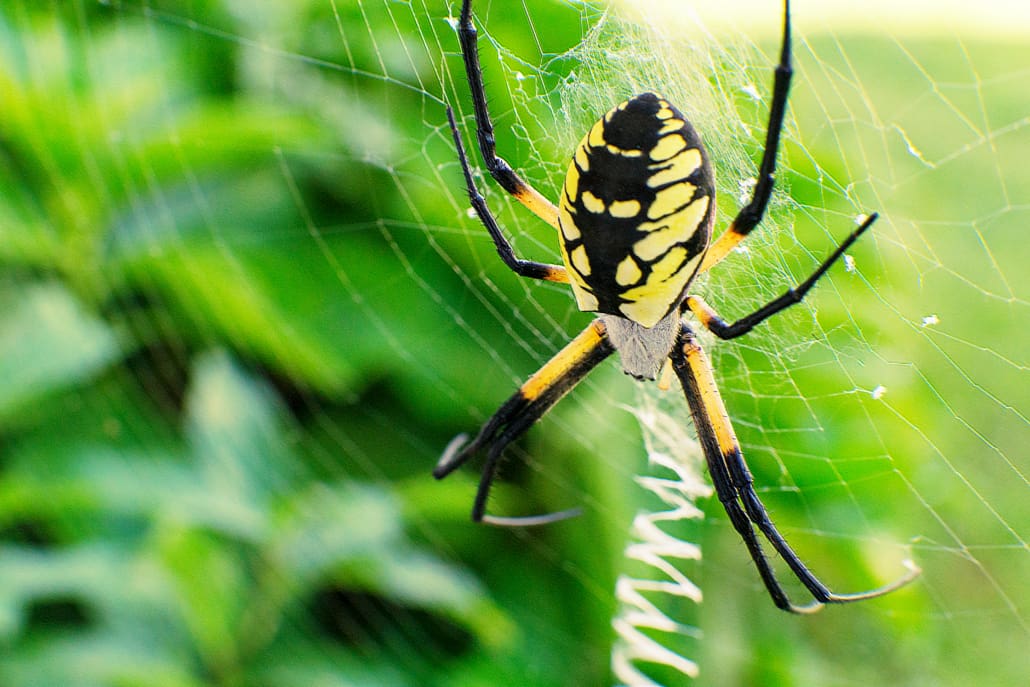
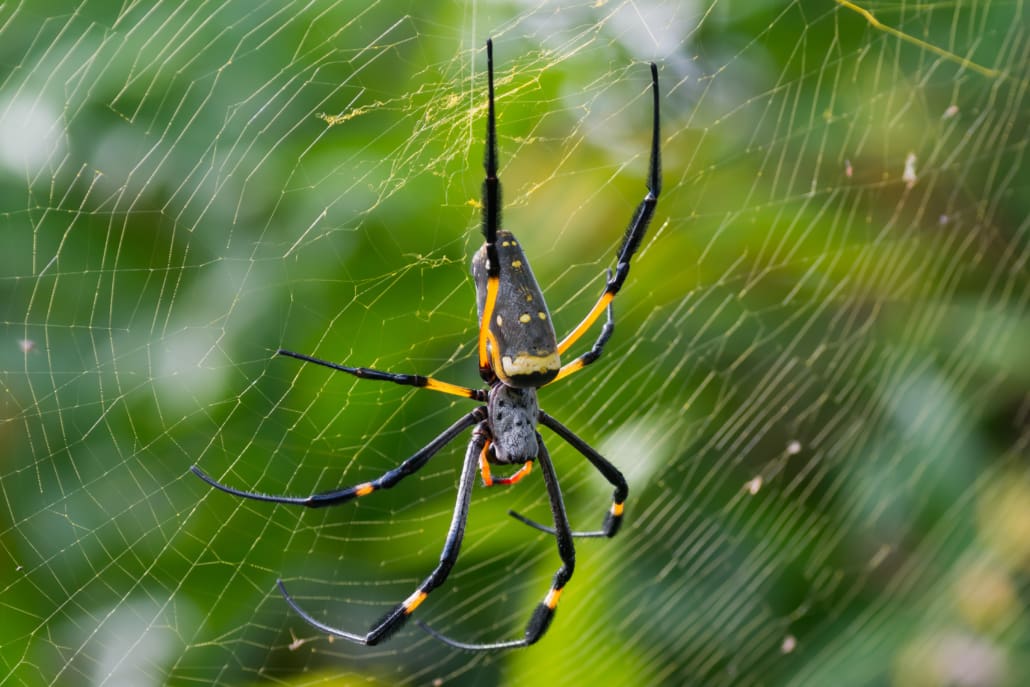
Types of Garden Spiders in the Pacific Northwest
Below, we’ll delve into what type of orb weavers we typically run into in some of our service areas at Pest Pros:
Orb Weaver Spider Washington State
Per the Pacific Science Center, one of the most common types of orb weaver spiders in Washington state are the garden orb weaver. You’ll most often see garden orb weaver spiders in autumn, although they’re around all year.
Seattle and the rest of the Western Region of Washington State are primarily home to the cross orb weaver, known for the white cross decorating its back. Eastern Washington State is typically home to the cat-faced orb weaver, with a trademark “cougar face” on its back.
Orb Weaver Spider Oregon
The typical types of orb weaver spiders in Oregon offer a habitat to be plentiful. A dozen separate orb weavers live across the state, including the cat-faced and cross-orb varieties found in Washington State. Also included in this list are the gray cross spider, trash line orb weaver, banded Argiope, and shamrock orb weaver, to name a few.
Do Garden Spiders Enter Homes?
Yes, Garden Spiders do enter homes.
However, you’re far likelier to find garden spiders on your home’s exterior. After all, they’re more adapted to the outdoors and prefer to spin their webs in high places to catch their flying insect prey.
Garden spiders thrive when they can live in the greenery on your home’s exterior. While these particular arthropods most commonly find habitat in your garden, they’re known to build webs outside of homes or in outdoor sheds and toilets since they’re unheated.
Typically, garden spiders like avoiding areas that are too hot and dry and where prey is plentiful.
The chances to hunt prey dwindle come the colder winter months. During this time, only the strong garden spiders survive after finding a location to partake in diapause, their version of hibernation.
Protection from frost is a garden spider’s top priority during diapause. They often nest in rotten logs and nooks in rocks. Yet, when they can leverage man-made options like an errant pair of garden gloves in a woodpile, they will.
At the same time, orb weavers will find their way into your home to build their webs. Provided your home is rife with tiny airborne insects, they’ll nest around areas with nightlights. However, they’ll also make webs around your home’s exterior on walls, fences, high tree branches, and bushes to store meals.
Are Garden Spiders Dangerous? Will They Threaten You or Your Home?
For the most part, you’ll find that garden spiders are nonaggressive and docile. That said, they will bite if they feel trapped or threatened or they’ve been stepped on. Their bites are similar to bee stings–and as has already been discussed–their bites result in little more than redness, swelling, and mild itching.
Provided you see a black and yellow garden spider in your garden, leave them to their business.
While a garden spider or orb weaver isn’t bound to cause substantial damage to your home, infestations aren’t ideal for any home.
Pest Control For Garden Spiders
The sticking point of the orb weaver spider is in their name–the webs they create against your home.
Sure, unlike a wolf spider or giant house spider, you aren’t likely to deal with a direct encounter or danger within your home–especially since orb weavers are nocturnal. However, orb weavers often have a high level of web production, leaving spider webs visible in corners of your home’s interior and exterior.
While orb weavers are ideal in your garden, you also don’t want your yard overrun with spiderwebs.
Sure, your home likely won’t face any substantial structural damage. But there’s still a matter of your comfort and the cleanliness of your home.
If garden spiders have infested your property, you must act fast. Reach out to Pest Pros for our expert spider control services. We’ll provide a solution ASAP to eliminate the problem now and prevent any further spider issues in the future.
Pest Pros Spider Pest Control Services
Let us tell you a little about ourselves and our spider pest control services at Pest Pros.
When treating your home for a spider infestation, we use material on your first-floor eaves to stop webbing from attaching to your exterior. Additionally, we equip exterior doorways with sticky traps to prevent orb weavers and other spiders from establishing themselves indoors.
From there, we offer suggestions to get rid of your home’s specific harborage points.
Often, we’re asked why we don’t spray for spiders. The answer is simple. Since spiders don’t have hooks but have pads on the end of their legs, there’s less surface for them to absorb pesticides.
Watch our video to learn more about our tried and true spider control process!
Call Pest Pros Today
Pest Pros has a team of reliable, licensed, and battle-tested professionals who know each pest problem is unique. We always provide a tailored, permanent solution to meet each customer’s needs, ensuring your infestation remains a distant memory.
If you need help with your pest control problem, whether Orb Weavers or anything else, contact Pest Pros today or request a free estimate.
Spiders are our friends, but you don’t need a swarm of these pests crawling around your home.
Likely you are at this blog because of dealing with an infestation you are eager to get rid of.
Regular house spiders aren’t alone as invaders of your home – they also have a nearby cousin, giant house spiders.
Throughout the article, we’ll discuss issues such as the giant house spider in Oregon and Washington State and the difference between the house spider and the giant house spider. We’ll also answer the question, “are giant house spiders dangerous?” Finally, we’ll discuss what to do if you have signs of an infestation and when to call a professional pest control company like Pest Pros.
Giant House Spiders vs House Spiders: The Difference Between The Two
A regular house spider either sits inside its funnel-like web; it waits for prey to land, then emerges rapidly for a meal, or creates a sticky web cluster for similar results. You’ll find males in your home during the late summer because they’re looking for mating partners.
So what is a giant house spider?
Giant house spiders are similar in almost every way to their regular-sized counterparts, including behaviors, but are a larger subspecies. They can grow up to 5-inches in leg span and 18mm in body length. Such long legs allow them to move at a 1.2 mph clip – making them one of the quicker spiders around.
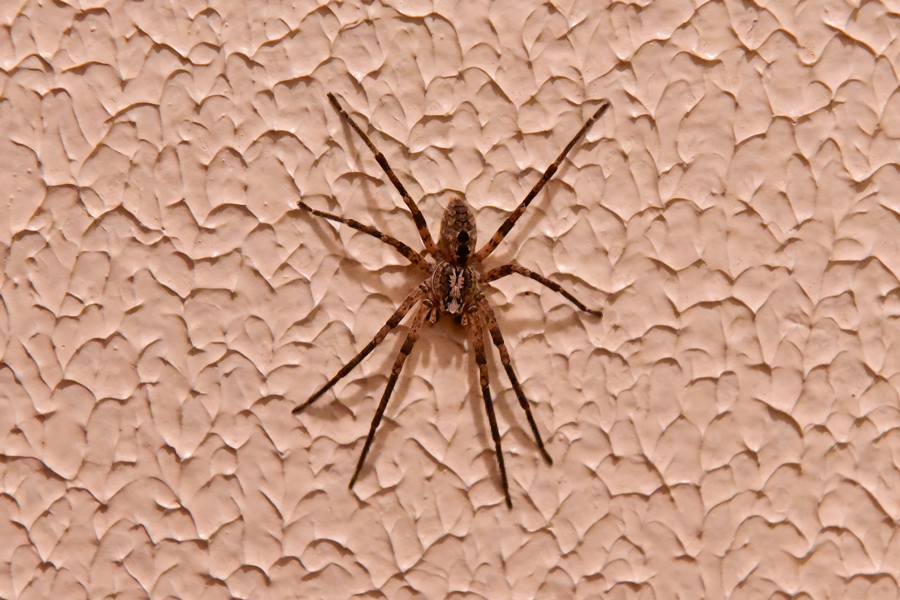

Giant House Spider In Washington State
Since Washington State (e.g., the Seattle area) is moist, it’s rich in spiders, including the regular house spider and giant house spider. This also extends to the entire Puget Sound. You’ll find them typically in your basement or garage.
Giant House Spider In Oregon
Since Oregon has similar conditions to Washington State, you’re bound to find them in your basement and garage in the Portland area and Lake Oswego.
How To Identify A Giant House Spider
The giant house spider’s size is its deadest giveaway.
Adult males have a leg span extending to five inches, while females’ legs can reach two inches. And they’re so large they can fit in your palm.
Color-wise, the giant house spider is primarily beige, brown, and dark orange. The abdomen of this enormous arthropod is gray, brown, and beige, and they don’t seem to have leg bandings.
You’ll see giant house spiders close to the floor since they aren’t the best climbers. However, they’re tenacious enough to reach cabinets and scurry up walls. They’ll also make their way into showers, tubs, cabinets, and dark basement corners.
Another infestation sign is when giant house spiders surround your flower beds, rock piles, logs, and other darkly lit sheltered sites.
Giant House Spider vs Hobo Spider
Hobo Spiders and giant house spiders are frequently confused with one another.
It’s tricky to differentiate the two spiders, but adult giant house spiders look alarmingly large, while adult hobo spiders are smaller in size.
Giant house spiders prevent hobo spider infestations because they out-compete them for habitat and prey. The giant house spider is known to kill male Hobo Spiders.
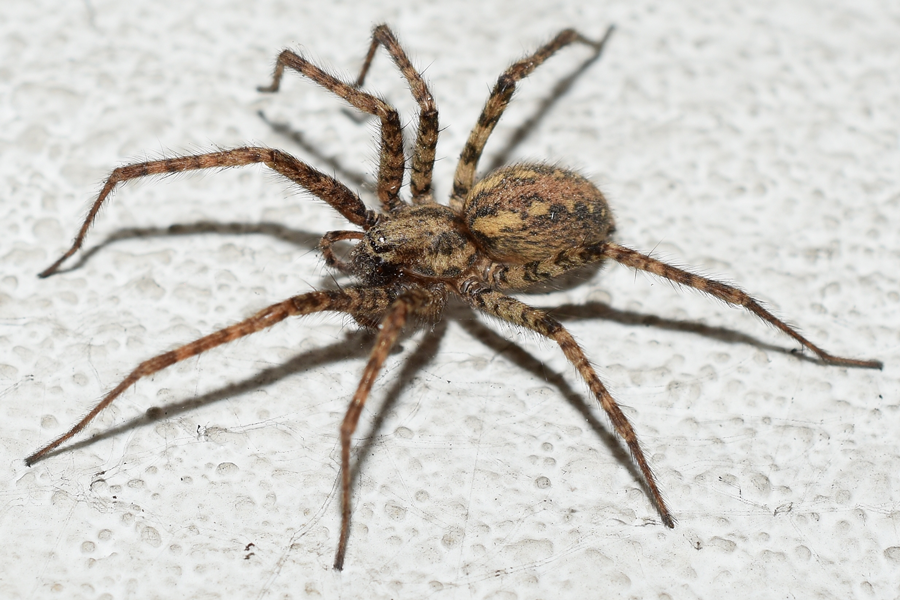
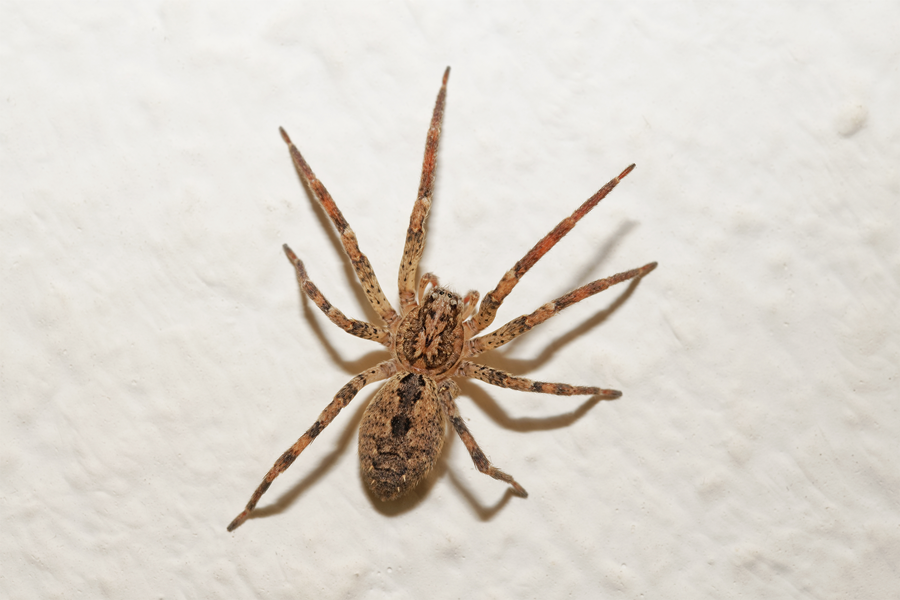
Are Giant House Spiders Dangerous?
No – giant house spiders aren’t dangerous.
There’s no need to panic if you see one. These large spiders don’t like to bite people since they can’t eat them. A giant house spider will only bite humans if they feel threatened and need to defend themselves.
While they are venomous, the venom only harms people with specific allergies.
In conclusion, this type of spider might appear menacing, but you aren’t under much threat in their presence.
Of course, just because giant house spiders won’t do you any direct harm doesn’t mean you want them crawling throughout your home.
Are Giant House Spiders A Threat To My Home?
The truth about most spiders, including giant house spiders, is that they don’t pose a catastrophic threat to your home.
Giant house spiders are ideal around the home, as they eat other pests like moths, cockroaches, mosquitoes, ants, fleas, and flies. Moreover, they help prevent hobo spider infestations.
Giant house spiders don’t leave their web during the day, focusing solely on trapping and devouring prey which makes them relatively undemanding houseguests.
However, this convenience factor wears thin when the giant house spider’s numbers start to grow. As helpful as they are, nobody wants pests scurrying around their home.
Factors such as clutter underneath areas such as chairs, furniture, beds, and couches attract giant house spiders. Similarly, an untidy kitchen attracts other pests, which lure in the giant house spiders because they seek other insect prey.
Long grass, trees, or flowers against the side of your home also attract giant house spiders. A 1.5 ft to 3 ft vegetation-free barrier is ideal but may be difficult to implement around certain homes. Additionally, these spiders love the inside of temperature-controlled homes because of the comfort offered.
Giant house spiders invade your home by hitching a ride in boxes or other belongings. They could also enter through gaps under doors and wall cracks while chasing prey, finding a mate, or just looking for better shelter.
If you’re seeing irregularly high numbers of giant house spiders in your home, you’ll need to call a professional pest control company to deal with the issue.
Every pest emergency is unique and requires a specialized approach to eradicate unwanted visitors for good. Contact our pest control professionals at Pest Pros to learn more about our expert pest extermination services in Washington.
How To Prevent Giant House Spiders:
- Keep your home as clean as possible. Reach every nook and cranny with cleaning products, a vacuum, and a duster. Wipe down counters, vacuum carpets, and mop hard surfaces to eliminate food particles.
- Switch off your outside lights, so attractive prey for giant house spiders are not drawn to your home.
- Remove the plants and vegetation from the side of your house so giant house spiders can’t hide in compost and wood piles.
- Receive frequent inspections from a professional pest control company. This way, you’ll have trusted experts to direct you on any corrective actions.
Receiving inspections from a company like Pest Pros keeps those numbers to where these spiders are a help and not a hindrance.
How To Get Rid Of Giant House Spiders:
- Use your vacuum and suck them up.
- Utilize a sticky trap.
- Remove your clutter and get rid of their homes.
- When needed, use insecticides sparingly.
- Purchase spider-catching glue traps.
Provided your home is infested with these eight-legged creatures, don’t try to fully DIY the issue.
Yes, some DIY measures might be helpful. However, not all are safe or good for the environment. Contacting a professional pest control company like Pest Pros will rid you of the problem promptly and permanently.
Contact A Professional Pest Control Company: Pest Pros
At Pest Pros, it’s our core mission to prevent any damage and future infestations from negatively impacting your living environment.
Our prompt, dedicated pest control technicians are committed to making your home feel like a home again and neutralizing any pest problem.
Get your life back to normal by calling or contacting us today for your free estimate. You can learn more on our website at www.gopestpros.com.
Bees, wasps, hornets, and yellowjackets are no stranger to the Pacific Northwest. While these insects offer many benefits to the ecosystems in our environment, you don’t want them living with you in your house. The first step of removal and exclusion is identification – and, when it comes to these flying, “stinging” insects, it can be difficult to tell them apart.
You may be wondering which type of pest is most likely to be a nuisance to you and your home. Read below as the expert team at Pest Pros explains the difference between bees vs. wasps vs. hornets vs. yellowjackets.
Types of Bees
There are over 20,000 species of bees in the world. So – what types of bees may be of interest to a Washington homeowner? The bumblebee and the carpenter bee are two common types of bees that may live around your home. Both types of bees can be easily identified by their furry body which regulates their body temperature and can act as an automatic pollen collector.

Bumblebees are almost harmless to homeowners since they nest in wax combs that hold their honey. Similarly, honey bees nest in wax combs however they produce honey in a much higher quantity and sometimes nest in the walls of houses which can be a danger to a house’s infrastructure.
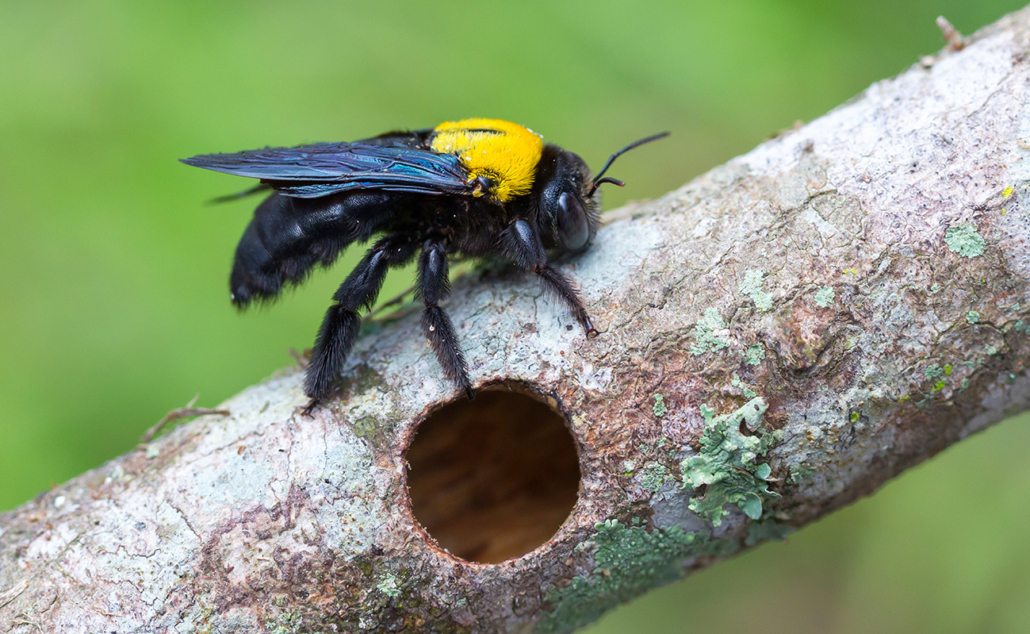
Carpenter bees, also known as wood bees, raise a mild threat to your house because they nest by drilling into wooden structures such as the baseboards of a house. Although their impact could lead to structural damage, it is uncommon that a carpenter bee raises serious trouble for a homeowner.
Bees, Wasps, and Hornets
The primary difference between bees, wasps, and hornets is the duties they carry out within the natural ecosystem, which also differentiates their diets. Bees are herbivores — meaning, they primarily eat plants and pollinate. Comparatively, wasps and hornets are omnivores, which means they prey on other insects as well as eat plants. As predators, wasps and hornets can help homeowners get rid of other unwanted insects in their homes but bring their own risks to the table.
Types of Hornets
Hornets are not naturally aggressive, but they are aggressive to humans and other nuisances that invade their space and threaten their colony. Bald-headed hornets are a common type of hornet in the Pacific Northwest.
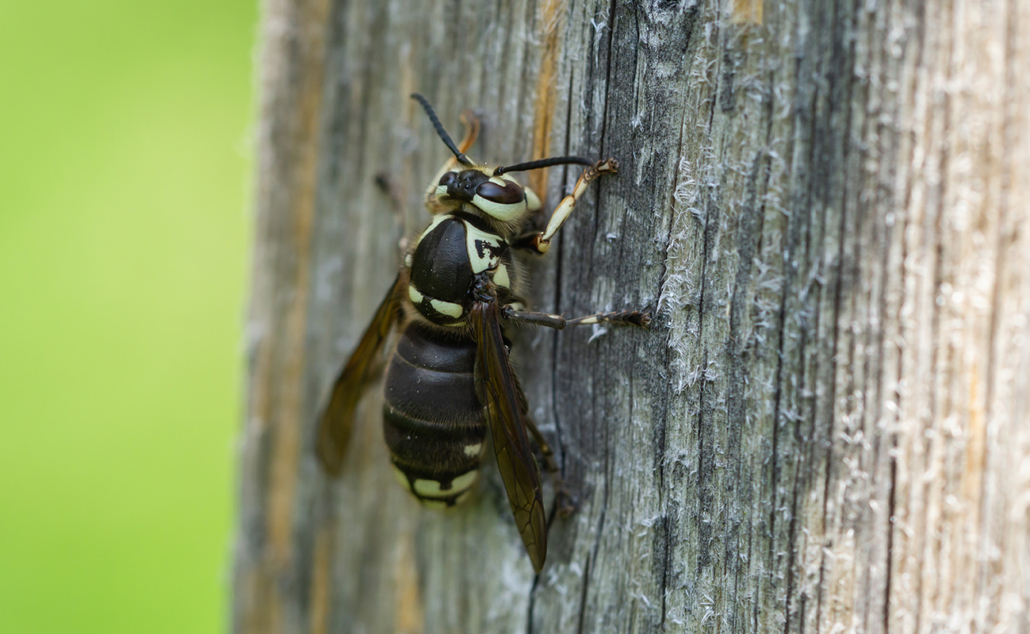
The jack of all trades, the bald-faced hornet, may nest in multiple locations; tree branches, a bush, the side of your home, garages, and other outdoor areas of your house.
Despite being just as aggressive as yellowjackets, bald-faced hornets can be distinguished by their white head and all-black body, which differs from yellowjackets’ black and yellow body.
Types of Wasps
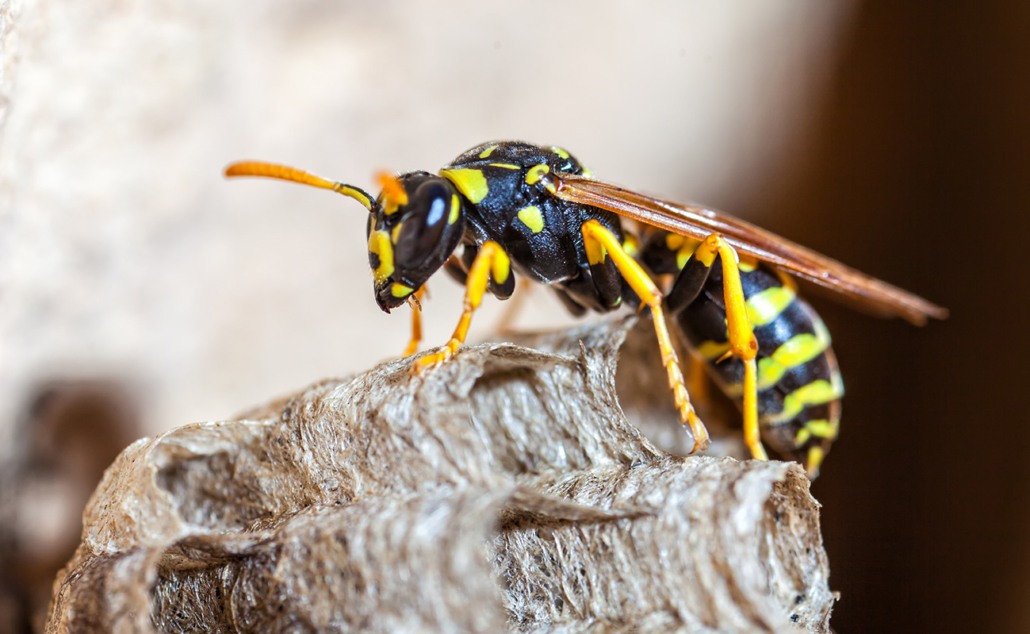
Similar to hornets, wasps will also become aggressive when they feel threatened. Wasps are black and yellow, however, are distinguishable from a bee by their slender and hairless body. Paper wasps are the most common type of wasp in Washington and tend to be solitary wasps.
Social wasps may choose to nest near neighborhoods and houses, especially in park areas. This may be a physical threat where outside activity is common. However, social wasps are less of a threat to homeowners as they typically nest in trees, leaves, branches, and other areas of nature.
Solitary wasps may cause trouble to homeowners as they can nest in sheltered places such as porch ceilings, roof corners, and other partially enclosed areas.
Yellowjackets vs. Wasps
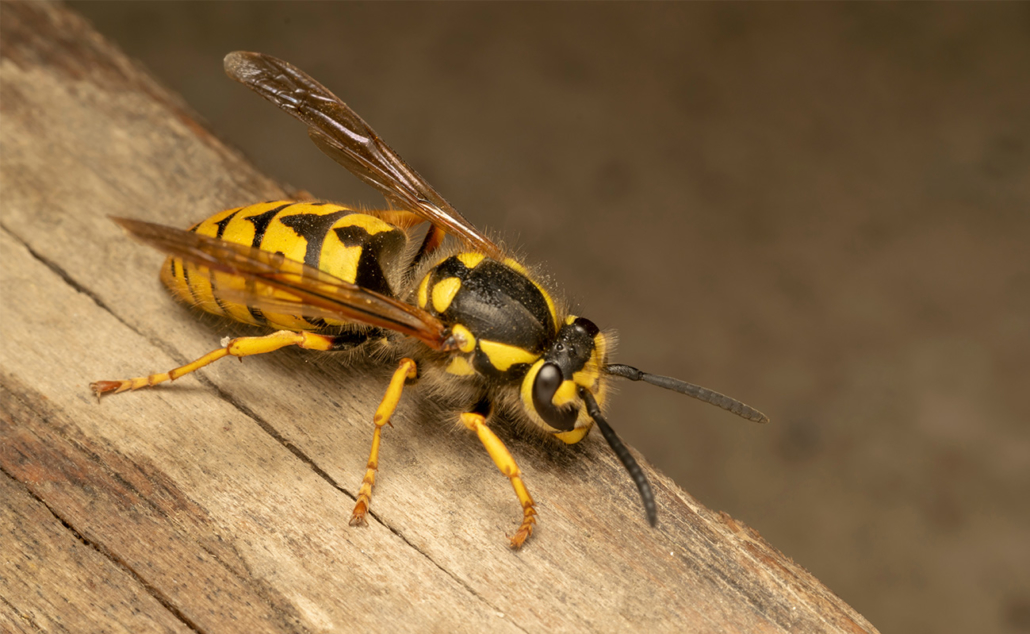
The yellowjacket, a common pest in the Pacific Northwest, is a member of the wasp species. The difference between yellowjackets and other wasps is that yellowjackets tend to be more curious and aggressive than the average wasp. You can easily identify yellowjackets by their black and yellow slender body.
Yellowjackets are attracted to content such as food and garbage. Yellowjackets will swarm areas with these smells to assess whether it’s a good place to find fuel and to nest near. This pest likes to nest closer to the ground in sheltered, dark corners such as house attics and deck stairs.
The good news is that they are known for killing other pests that you may not want in or around your home such as house flies. The bad news is that they are more persistent and aggressive than the average pest they may be preying on.
Why are Bees, Wasps, and Hornets Problematic?
While bees, wasps, and hornets have their differences, they all can be classified as pests that homeowners don’t want to intrude into their homes. Bees, wasps, and hornets all find house structures and backyards the perfect place to create a home for the season, which is a reason to take preventative measures to ensure your house is protected. Pests like carpenter bees, paper wasps, bald-faced hornets, and even honeybees can be a threat to your home’s insulation and infrastructure.
Carpenter bees create circular tunnels throughout the wooden structure of homes causing them to become weak and eventually sink or bust. Similarly, solitary wasps, like paper wasps, will also drill into the wood infrastructure of houses causing damage to the foundation of a home.
Although less common, honeybees will choose to nest within house walls. The honeycomb formed in the nests can directly damage the insulation of your home, especially after the bees abandon the comb, leaving melted honey behind.
Not to mention that an infestation can be a physical danger to you and your family when bees, wasps, hornets, and yellowjackets create a nest on your property.
Signs You Have Bees, Wasps, Hornets, and Yellowjackets in Your Home
Having a bee, wasp, or hornet infestation is often easy to identify due to each of their pesky nature. However, if you are unsure, here are some common signs that you may have a pest problem:
- Increase in bee activity around the house
- Smooth round holes in wood infrastructure on the outside of the house
- Sawdust piles
- Structural damage to the outside of the house
- Sound of buzzing in your walls
- Dark spots on the inside and outside of the house walls
How Do You Get Rid of Bees, Wasps, and Hornets?
Prevention
Homeowners should take preventative measures to stop bees, hornets, and wasps from infesting their homes and property.
- Repair any cracks along with the siding of your house
- Repair and seal cracks around house windows and doors
- Keep all food and garbage stored in tightly closed containers
- Use natural repellents like peppermint oil or dryer sheets around your home, sunroom, and porch areas
DIY Solutions
If you do encounter an increase in bee, wasp, or hornet activity around your home, you can try these DIY solutions for dealing with these pests. However, dealing with these pests can be dangerous, especially when going to the source of the infestation. DIY solutions rarely solve the problem but instead worsen the issue so it’s more difficult for professionals to solve once they’re called. The best solution for pest infestations is finding professional pest spraying services.
If you do tackle a DIY solution, be sure to take the safety protocols needed such as wearing protective face and body gear and planning an escape route to ensure you have a way out if the bees, wasps, or hornets attack.
Natural
- Spray an infested area including the nest with a soap and water mixture.
- Create homemade traps with a sugary substance such as soda or fruit juice.
Unnatural
- Spray an infested area with insecticides – a product created to kill pests and their nest.
Contact a Professional Pest Control Company: Pest Pros
If you find that you have a bee, wasp, or hornet infestation, the best solution that we recommend is to call a professional pest control company, like Pest Pros.

- Inspect and identify the type of bee, hornet, or wasp
- Exclusion – limiting the pest to a confined area
- Least-invasive pest treatment
- Additional pest services (if needed)
- Maintenance
Pest Pros technicians are prepared to provide expert knowledge about the best practices for dealing with each type of bee in the least invasive and safest way possible. Using professional pest control services such as Pest Pros ensures that the job is done right and safely.
It is Pest Pros’ top priority to offer services that will prevent your house from further damage, and future infestations and ensure your house feels like a home. Our team is prompt, professional, and dedicated to taking care of any pest problems in your home and getting your life back to normal. Call us or contact us for your free estimate today!
As winter sets in, we stay indoors to protect ourselves from the nasty winds and weather. Turns out, pests do the same thing — seeking refuge in a warm place, which is oftentimes your home. Although homeowners avoid consciously thinking about it during the holiday season, the reality is that winter is an ideal time for pests to infiltrate your home. Pest Pros is here to provide you with options when it comes to setting a budget to prevent unexpected pest control costs and before you start to find signs of unwanted house guests.
Benefits of Budgeting for Pest Control Services
Setting up a pest control budget allows professionals to care for your pest control needs while saving you, a homeowner, peace of mind knowing you are putting your best foot forward to care for your home and those inside of it.
Benefits of Professional Pest Control Services
The primary goal of pest control is to create a strategy that will help reduce the number of pests in the home to an acceptable level. An acceptable pest control situation is one that prevents and stops damage caused to the home itself. The overall goal of pest control is prevention, exclusion, and removal. Whether in-home pests are present in abundance or sporadically, take preventative measures to ensure your home’s safety and protection.
Suppose pests already reside in the house with the proper treatment; in that case, the objective is to decrease the number of insects to an acceptable level. On the other hand, exclusion techniques are strategies implemented to keep the harmful pests entirely out of the home.
Setting up a pest control budget allows professionals to care for your needs while saving time, money, and preventing potential health issues. These specialists know their habits, breeding grounds, and life cycles. This allows them to make you aware of the openings that have allowed them to intrude in your home and target them for exclusion pest prevention.
Like vital home upkeep tasks such as doing your laundry and dishes, treatment for pest control is ongoing. However, unlike other chores, the frequency depends on the type of critter. During the time it takes to identify the pest, locate its entry point and hiding spots, and selecting the type of pesticide to use, the colony is likely to have continued growth. Not to mention that using the wrong kind of pesticide could have potential consequences on your family’s health.
To minimize this risk, specialists are well versed in assessing the correct type of product to use. Trained technicians can carefully use controlled pesticides, knowing the proper placement to ensure harmful toxin exposure doesn’t affect you and your loved ones.
Lastly, an exterminator can direct you to the places where these pests live in your home and help you create a game plan to close those entry points and prevent new ones.
Factors Affecting Pest Control Costs
Unfortunately, pest management is not a one-size-fits-all solution. There are numerous factors associated with an exterminator cost. The price is usually determined by:
- Size of infestation: If the issue extends beyond one area.
- Service type: If given options to combat the problem, some may cost more than others.
- Property size: Control and prevention tactics usually center around an area or the perimeter of the home. Pest control cost per square foot may increase depending on the property size.
- Frequency: If the treatment plan calls for pest control visits every other month, the fee per session will cost less than one individual session. Pest Pros offers a recurring payment schedule for every other month visits and one time payment fees for one time visits.
The last factor determining pest control cost is the type of pests such as spiders, ants, wasps, hornets, flies, or rodents, that you’re dealing with, as some pests are more difficult to eradicate than others. Although you may have an idea of the initial measures to take, an exterminator will conduct a thorough inspection and quickly determine what exactly you’re up against.
Typical pest infestation solutions can usually start as low as $375 (plus tax) for the first visit and then $95 (plus tax) every other month to maintain a pest guarantee. Home construction and pest infestation levels vary and custom quotes can be provided on site or by phone. Some pest services, such as for Wasps, may start as low as $250 (plus tax.) For the most accurate pricing for your pest infestation, contact Pest Pros.
Based on the easiest to most challenging to manage pests, here is a typical pest control price list:
Is Quarterly Pest Control Worth It?
It’s always better to take preventative measures to protect your home from intruders. Initial visits range between $90 to $350. The exterminator will assess the problem, locate the nest, find their point of entry, and create a plan if necessary. One-time visits for pests such as roaches, bees, wasps, and bedbugs may have an immediate solution. Still, these pesky critters will always try to come back.
A
Monthly – Pest Management services on a monthly basis typically start at $100 (plus tax.) This frequency best serves commercial facilities, apartment complexes, condos, and multifamily dwellings. Pest pressure for these locations is much higher than a typical residential setting and demands greater frequency of inspections to prevent large pest outbreaks. At times, this frequency is necessary for residential single family homes for a period of time to bring a large pest infestation under control, and is then scaled back to every other month.
Every Other Month – Pest Management services on an every other month basis can range between $95-$105 (plus tax) for most residential single family homes. This frequency allows for adequate visits to keep pests under control and remain budget friendly. If pests come back between services, then so do we, at no additional charge.
Scheduling ongoing pest management services is a great option for homeowners desiring to prevent unwanted guests and creates a fixed budget without fear of unexpected costs. Hiring a pest management professional protects your family and pets from misapplication of pesticides and reduces overall dependence and overuse of pesticides. This is nearly impossible to achieve when attempting control with over the counter products without adequate training and specialized knowledge. By and large, a homeowner would expect to spend about $570 to $630 per year to maintain pest protection. A small price to pay for large peace of mind.
Contact Pest Pros for a No-Cost Estimate
Allowing professionals to take care of your unwanted pest allows you more time to enjoy yourself with your loved ones. Although the DIY option may seem enticing, it can potentially cause damage to your home and your health.
Pest Pros understands and wants to be your partner in protecting the investment you made in your home. We serve our community by offering a no-cost pricing estimate. We simply deliver what we say we will; that’s our guarantee.
Pest Pros Free Estimate
"*" indicates required fields
If you live in Washington state, you most likely have a story about being confronted with a big, hairy wolf spider in your home or backyard. Unfortunately, wolf spiders are a common intruder in Pacific Northwestern homes. You might be wondering where these unwelcome house guests come from, and what can be done to keep them outdoors. As temperatures cool down and autumn weather rolls in, wolf spiders in Washington begin to leave the comfort of their grassy habitats to seek cover in the unsecured crevices of your home. Once they infiltrate your residence, they are known to hide among the clutter of your living space, only making themselves known when you unsuspectingly move a box or appliance.
While they may look as intimidating as their namesake would suggest, the good news is that wolf spiders are mostly harmless to your family. Here is everything that you need to know about how to get rid of wolf spiders in your house, as explained by the experts at Pest Pros.
Wolf Spider Identification
How do you know if the creepy crawly that has made itself at home is a wolf spider? Here are a few things to watch out for:
- Eye Orientation – Like all spiders, these pests have 8 eyes and 8 long, hairy legs. However, unlike most spiders, wolf spiders have their eyes arranged in 3 rows to better hunt their insect prey. The same sharp vision that they use to find entry points into your home is used to ambush their unsuspecting victims.
- Speed – If you’ve stumbled upon a wolf spider in your home, you may have noticed that they scurry away very quickly and are difficult to catch up with and trap. This is because wolf spiders do not create webs to trap their prey, opting to instead use their long and quick legs to pounce onto smaller bugs before they even realize that the spider is there!
- Size – While these pests can be found on both coasts of the United States, the size of wolf spiders in Washington can range anywhere from 1 to 4 inches in length. In other areas of the west coast, they can even grow to be a bit longer than 4 inches including their legs. They tend to be more scaled down in size on the east coast.
- Eggs on Abdomen – The most distinct feature that sets wolf spiders apart from other arachnids is the fact that mother spiders carry their babies on their abdomen, making wolf spider extermination to be a tricky task to undertake without potentially making the problem even worse.
Are Wolf Spiders Dangerous?
Unlike the more poisonous brown recluse spider, wolf spiders tend to loiter in less secluded and more easily accessible areas of the home. Even so, they tend to be quite shy and avoid humans as much as they can. The main goal of the wolf spider during this time of year is to stay warm and away from the frigid autumn weather, and they do not like to be disturbed. Because of this, they do not often bite unless they have been thoroughly disturbed and are distressed.
While being bitten by a wolf spider is unlikely, it is still something that can happen. When these spiders do bite, their fangs inject a mild venom that is non-lethal to humans. Their bites are powerful enough to kill their prey, but do not have much of an effect on us; on average, we are 500 times larger than the size of a wolf spider’s typical prey. The most common reaction that humans have to a wolf spider bite is swelling and potentially a mild fever. This is not unlike the symptoms of being stung by a wasp.
While wolf spiders are not fatally poisonous to humans, they are still an unpleasant uninvited house guest that can live for about a year.
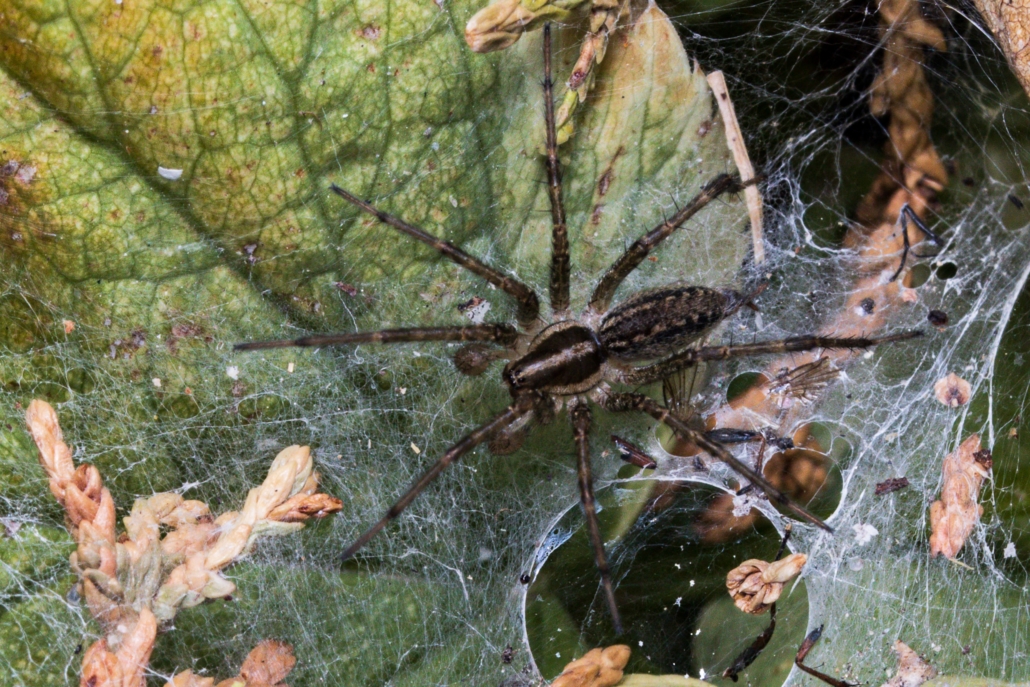
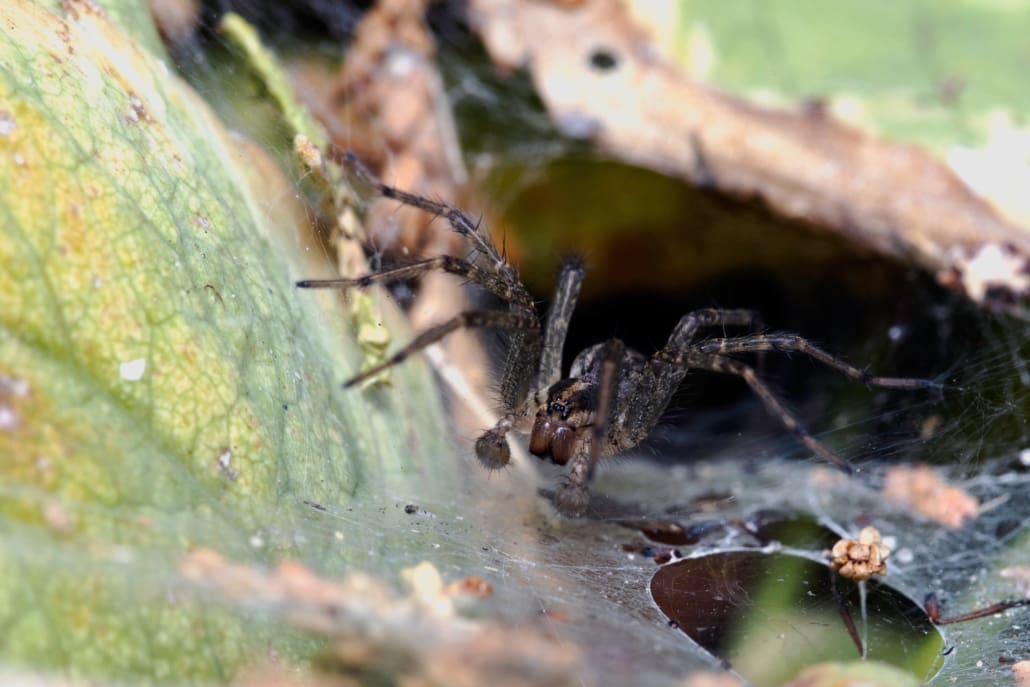
How to Get Rid of Wolf Spiders
If a wolf spider has already found its way into your home, the best way to avoid accidentally releasing the hundreds of spider hatchlings that female wolf spiders ferry around is to trap your new uninvited house guest. The worst thing that you can do is allow your arachnophobia to take over and attempt to squish the spider in a panic; this is to be avoided at all costs! Unless you are looking for a few hundred new 8-legged pets, it is best to find a container to put over the spider to escort it out of your home.
The best way to exterminate a wolf spider is to find a way to keep them out of your home in the first place. There are various ways that this can be done by creating physical barriers that disallow entry:
- Add weather stripping to seal the entryways of your home’s windows and doors.
- Caulk the cracks and holes that expose your inner and outer walls to the outside.
- Repair any openings that you find immediately; it won’t take wolf spiders very long to find them once they start looking!
- Clear all clutter inside of your home where they can comfortably hide. Wolf spiders love their privacy and will take up residence in clutter!
- Clear debris outside of your home where they can camp out while waiting for an opportunity to slip in. This includes removing mulch and tall vegetation from around your home’s foundation.
Since wolf spiders prey on insects, another great way to discourage them from sticking around is to reduce the number of small bugs that will be attracted to your residence. This can be done by dimming the lights on the exterior of your home to avoid attracting the small flying insects that they love to snack on. If you have a problem with small bugs infesting your home, solving this first might help solve your wolf spider dilemma as well.
Your local licensed pest control professionals will be able to offer the best solution to your infestation.
Call Pest Pros for Wolf Spider Extermination
Every pest emergency is unique and requires a specialized approach to eradicate unwanted visitors for good. Contact our pest control professionals at Pest Pros to learn more about our expert pest extermination services in Washington.
